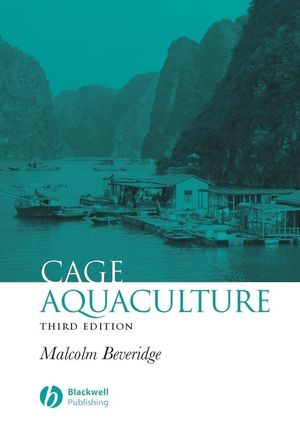Cage Aquaculture, 3rd EditionISBN: 978-1-4051-0842-3
Paperback
380 pages
November 2004, Wiley-Blackwell
 This is a Print-on-Demand title. It will be printed specifically to fill your order. Please allow an additional 10-15 days delivery time. The book is not returnable.
|
||||||
ACKNOWLEDGEMENTS.
1 CAGE AQUACULTURE - ORIGINS AND PRINCIPLES.
1.1 Principles of aquaculture.
1.2 Rearing facilities.
1.3 The origins of cage culture.
2 CAGE AQUACULTURE - AN OVERVIEW.
2.1 Diversity of cage types.
2.2 Cages and cage aquaculture.
2.3 Cage culture and aquaculture.
2.4 Advantages and disadvantages of cage culture.
3 CAGE DESIGN AND CONSTRUCTION.
3.1 Size, shape and materials.
3.2 Traditional designs.
3.3 Modern designs.
Appendix 3.1 Current force on a single panel of a net cage (from Løland 1993a).
Appendix 3.2 Example of computation of cage flotation computation.
Appendix3.3 Calculation of the buoyancy of a 3 x 3 x 3 m bamboo cage (see Section 3.3.2).
4 SITE SELECTION.
4.1 Environmental criteria for farmed aquatic species.
4.2 Environmental criteria for cages.
4.3 Site facilities and management.
4.4 Concluding remarks.
5 ENVIRONMENTAL IMPACTS AND ENVIRONMENTAL CAPACITY.
5.1 Resource consumptiion.
5.2 The cage aquaculture process.
5.3 Wastes.
5.4 Modelling environmental capacity.
Appendix 5.1 Example of intensive cage rainbow trout production assessment for a temperate natural lake.
Appendix 5.2 Example of extensive cage tilapia production for a tropical reservoir.
Appendix 5.3 Example of semi‑intensive cage tilapia production assessment for a tropical lake.
6 MANAGEMENT.
6.1 Transport and stocking.
6.2 Feeds and feeding.
6.3 Routine management.
7 PROBLEMS.
7.1 Currents.
7.2 Disease.
7.3 Drifting objects.
7.4 Fouling.
7.5 Oxygen.
7.6 Security.
7.7 Predators and scavengers.
7.8 Wastes.
7.9 Weather and climate.
Appendix 7.1 Example of calculation for aeration system design for freshwater rainbow trout cage.
References.
Index.



